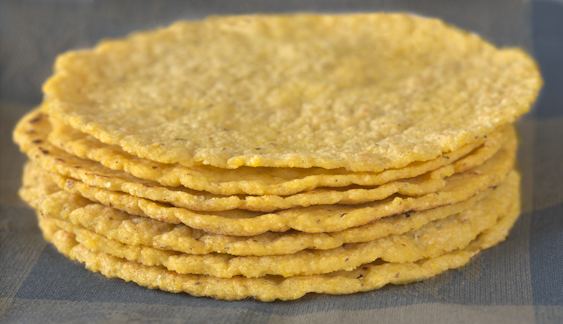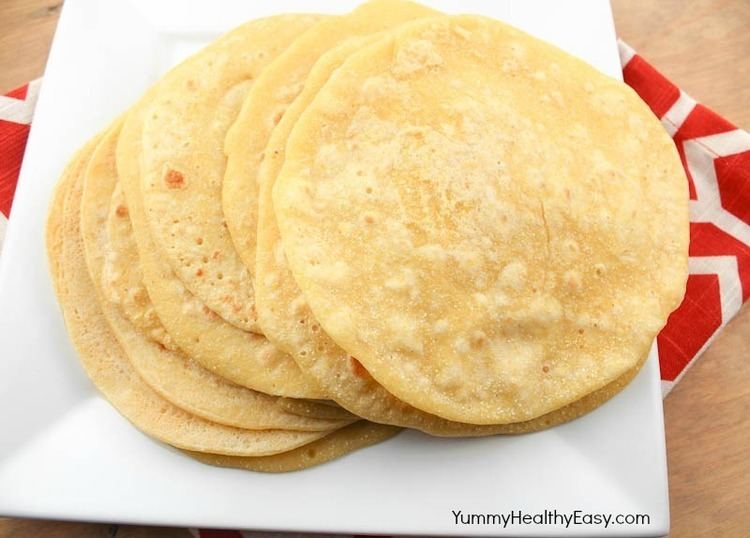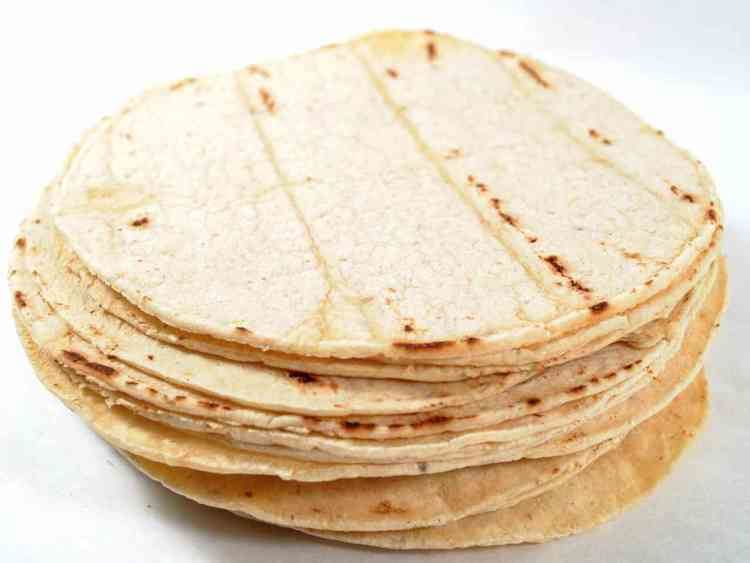Main ingredients Maize flour | ||
 | ||
Similar Wheat tortilla, Taco, Enchilada, Burrito, Quesadilla | ||
Homemade corn tortillas
In Mexico and Central America, a tortilla is a type of thin, unleavened flat bread, made from finely ground maize (corn). In Guatemala and Mexico, there are three colors of maize dough for making tortillas: white maize, yellow maize and blue maize (or black maize).
Contents
- Homemade corn tortillas
- Etymology
- History
- Mexico and Central America
- Nutrition
- Tortilla making
- Uses
- References

A similar bread from South America, called arepa (though arepas are typically much thicker than tortillas), predates the arrival of Europeans to America, and was called tortilla by the Spanish from its resemblance to the traditional Spanish round, unleavened cakes and omelettes (originally made without potatoes, which are native to South America). The Aztecs and other Nahuatl-speakers call tortillas tlaxcalli [t͡ɬaʃˈkalli]; these have become the prototypical tortillas.
Maize kernels naturally occur in many colors, depending on the cultivar: from pale white, to yellow, to red and bluish purple. Likewise, corn meal and the tortillas made from it may be similarly colored. White and yellow tortillas are by far the most common, however.
Etymology

Tortilla, from Spanish torta, cake, plus the diminutive -illa, literally means "little cake". Nahuatl tlaxcalli is derived from the verb (i)xca "to bake" with the help of the prefix tla- and two common suffixes -l- and -li (<-tli), that is "something baked".
History

The corn tortilla, with many variants, has been a staple food in North American and Mesoamerican cultures since pre-Columbian times. It predates the alternative wheat flour version of the tortilla (tortilla de harina or tortilla de trigo) in all such cultures, as wheat was not grown in the Americas prior to European contact.
In Aztec times, two or three corn tortillas would be eaten with each meal, either plain or dipped in mole or a chili pepper and water sauce. Tortillas were also sold at Aztec marketplaces filled with turkey meat, turkey eggs, beans, honey, squash, tuna (a type of cactus fruit) and chili pepper.
Analogous staple foods in New World cultures, made from nixtamal and serving a similar nutritional function, include the sope, the totopo, the gordita, and the tlacoyo of Mexico, the pupusa of Central America, and the arepa of northern South America.
The tamal (or tamale) of Mexico, Central America and northern South America is also made from nixtamal, but is much thicker and is a dish unto itself, usually including other ingredients and flavors, rather than a staple food used in other dishes.
Mexico and Central America
Maize has been a staple food for centuries. It is the most planted crop in the Mexican region. The country grows more than 42 different types of maize, each of which has several varieties whose number is estimated at more than 3,000 by the International Center for the Improvement of Maize and Wheat (CIMMYT). The characteristics of each variety depend upon soil conditions, humidity, altitude, and how cultivated. Some of the earliest evidence of maize cultivation suggests that domestication took place in several places at the same time.
Maize is the basis of most Mexican cuisine, with some exception in the culinary traditions of northern Mexico, where wheat is taking the place of maize as the cereal base. The primary way in which maize is consumed in Mexico is the tortilla, but it is also a necessary input for the preparation of almost all types of tamales, atoles and snacks. The maize used for tortillas can be ripe and dry, but it is also consumed fresh and mature (maize), or soft and fresh (xilote).
Tortillas are consumed daily. Factory-made tortillas are widely sold, and they can easily be home-made. Tortilla production starts from early morning because lunch is the main meal of the day for most people. In Mexico, lunch is eaten between 1:30 p.m. and 3:30 p.m. Some supermarkets and grocery stores sell tortillas, throughout the day.
Tortillas come in several different flavors and colors according to the kind of maize used. Tortillas come with all the traditional foods of Mexico, though not with all the fillings that are used these days.
Mexican and, more generally, Latin American dishes made with maize tortillas include:
Mexican burritos are made with flour tortillas. For some uses, such as quesadillas, either maize or wheat tortillas can be used.
Nutrition
The preparation of maize in an alkaline solution of mineral lime or calcium hydroxide, used in the production of flour for corn tortillas, significantly enriches the nutritional value of maize as a source of vitamins, minerals and protein. The limewater used in the process adds its own bioavailable calcium, while it also renders the B vitamins and amino acids in maize far more easily absorbable by the human digestive system.
The process, called nixtamalization, was developed indigenously by pre-Columbian cultures and predates European contact by many centuries, if not millennia.
Tortilla making
A tortilla seller is, in Nahuatl: tlaxcalnamacac [t͡ɬaʃkalnaˈmakak] or Spanish: tortillero [toɾtiˈʝeɾo]. The traditional tortilla has been made of maize corn since pre-Columbian times. It is made by curing maize in limewater in the nixtamalization process, which causes the skin of the corn kernels to peel off (the waste material is typically fed to poultry), then grinding and cooking it, kneading it into a dough called masa nixtamalera, pressing it flat into thin patties, and cooking it on a very hot comal (originally a flat terra cotta griddle, now usually made of light sheet-metal instead).
Soaking the maize in limewater is important because it makes available the B vitamin niacin and the amino acid tryptophan. When maize was brought to Europe, Africa and Asia from the New World, this crucial step was often omitted. Those whose diet consisted mostly of corn meal often became sick — because of the lack of niacin and tryptophan — with the deficiency disease pellagra, which was common in Spain, Northern Italy, and the southern United States.
In Mexico, particularly in the towns and cities, corn tortillas are often made nowadays by machine and are very thin and uniform, but in many places in the country, they are still made by hand, even when the nixtamal is ground into masa by machine. In Belize, El Salvador, Guatemala, or Honduras, they are still often made by hand and are thicker. Corn tortillas are customarily served and eaten warm; when cool, they often become rubbery or grainy as the cooked starches stale. The largest tortilla producer in the world is the Mexican company Gruma, headquartered in Monterrey.
Traditionally throughout Mesoamerica from pre-Columbian times into the mid-20th century, the masa was prepared by women using a mano (a cylinder-shaped stone like a rolling pin) and metate (a stone base with a slightly concave top for holding the corn). This method is still used in some places in Mexico.
The wheat flour tortilla was an innovation after wheat was brought to the New World from Spain while this region was the colony of New Spain. It is made with an unleavened, water-based dough, pressed and cooked like corn tortillas. These tortillas are very similar to the unleavened bread popular in Arabic, eastern Mediterranean and southern Asian countries, though thinner and smaller in diameter. In China the laobing (烙餅), a thick circular "pancake", is similar to the tortilla. The Indian roti, which is made essentially from wheat flour, is another example.
Tortillas vary in size from about 6 to over 30 cm (2.4 to over 12 in), depending on the region of the country and the dish for which it is intended.
Among tortilla variants (without being, strictly speaking, tortillas) there are pupusas, pishtones, gorditas, sopes, and tlacoyos. These filled snacks can be found in Mexico, Belize, Guatemala, El Salvador and Honduras. They are smaller, thicker versions to which beans, chicharrón, nopales or other ingredients have been added. They are customarily cooked on a greased pan.
In Nicaragua, a type of tortillas called güirilas are also consumed. They are made from young white corn. Güirilas are thick, sweet and filling. They are eaten alone, with crumbled cheese, or accompanying a dish.
In Argentina, Bolivia and southern Chile, the size of the tortillas is smaller. They are generally saltier, made from wheat or corn flour, and roasted in the ashes of a traditional adobe oven. This kind of tortilla is called sopaipilla (not to be confused with a puffy frybread of the same name common in the United States). In Chile and Argentina, it may also be sweetened after being cooked by boiling in sugar water.
In commercial production and even in some larger restaurants, automatic machines make tortillas from dough.
Uses
Corn tortillas are the basis of many traditional Mexican dishes, such as tacos, tostadas, enchiladas, flautas, quesadillas, chilaquiles, and tortilla soup (sopa de tortilla). Warmed corn tortillas are also often served as an accompaniment to stews, soups, grilled meats and other dishes, as bread might be served in other cuisines.
By contrast, wheat flour tortillas are often used for burritos and quesadillas, particularly in the United States.
Corn tortillas may also be deep fried to make crisp tortilla chips. These are often salted, and can be eaten alone or accompanied with various salsas and dips such as guacamole. Tortilla chips are a key ingredient in nachos.
